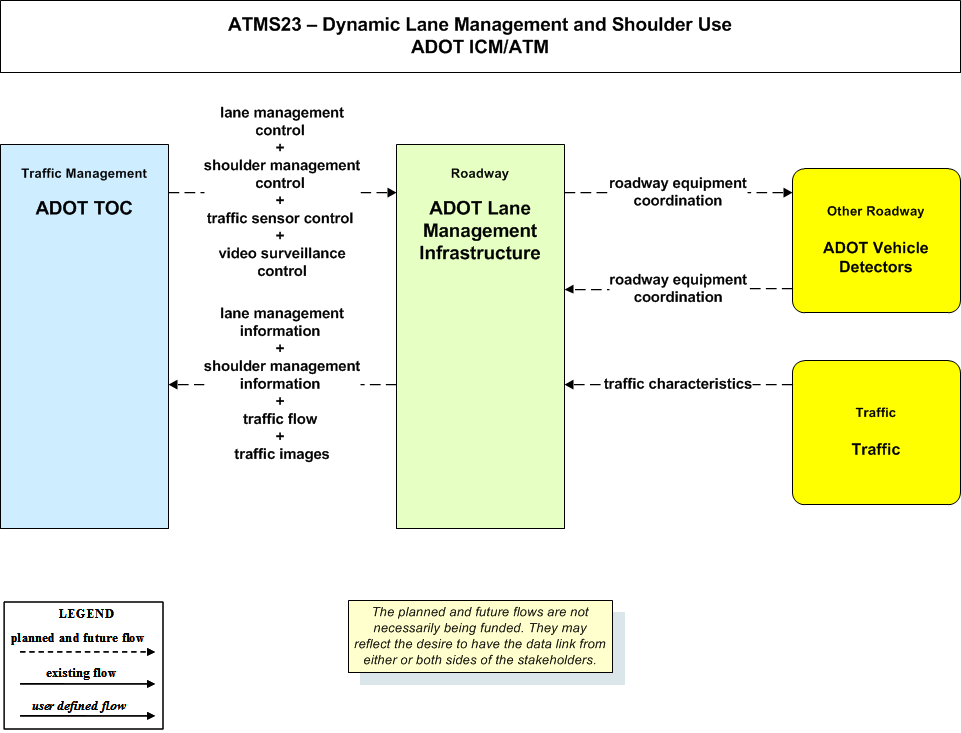| Arizona Department of Transportation |
ADOT Lane Management Infrastructure |
Roadway Dynamic Lane Management and Shoulder Use |
This equipment package includes the field equipment, physical overhead lane signs and associated control electronics that are used to manage and control specific lanes and/or the shoulders. This equipment can be centrally controlled by a traffic management center or it can autonomous and monitor traffic conditions and demand along the roadway and determine how to change the lane controls to respond to current conditions. Lane controls can be used to change the lane configuration of the roadway, reconfigure intersections and/or interchanges, allow use of shoulders as temporary travel lanes, designate lanes for use by special vehicles only, such as buses, high occupancy vehicles (HOVs), vehicles attending a special event, etc. and/or prohibit or restrict types of vehicles from using particular lanes. Guidance and information for drivers can be posted on dynamic message signs. This equipment also can automatically notify the enforcement agency of violators of the lane controls. |
| Arizona Department of Transportation |
ADOT TOC |
TMC Dynamic Lane Management and Shoulder Use |
This equipment package remotely monitors and controls the system that is used to dynamically manage travel lanes, including temporary use of shoulders as travel lanes. It monitors traffic conditions and demand measured in the field and determines when the lane configuration of the roadway should be changed, when intersections and/or interchanges should be reconfigured, when the shoulders should be used for travel (as a lane), when lanes should be designated for use by special vehicles only, such as buses, high occupancy vehicles (HOVs), vehicles attending a special event, etc. and/or when types of vehicles should be prohibited or restricted from using particular lanes. It controls the field equipment used to manage and control specific lanes and the shoulders. It also can automatically notify the enforcement agency of lane control violations. |
| Arizona Department of Transportation |
ADOT TOC |
Collect Traffic Surveillance |
This equipment package remotely monitors and controls traffic sensors and surveillance (e.g., CCTV) equipment, and collects, processes and stores the collected traffic data. Current traffic information and other real-time transportation information is also collected from other centers. The collected information is provided to traffic operations personnel and made available to other centers. |
| Arizona Department of Transportation |
ADOT TOC |
Traffic Equipment Maintenance |
This equipment package monitors the operational status of field equipment and detects failures. It presents field equipment status to Traffic Operations Personnel and reports failures to the Maintenance and Construction Management Subsystem. The equipment package tracks the repair or replacement of the failed equipment. The entire range of ITS field equipment may be monitored by this equipment package including sensors (traffic, infrastructure, environmental, security, speed, etc.) and devices (highway advisory radio, dynamic message signs, automated roadway treatment systems, barrier and safeguard systems, cameras, traffic signals and override equipment, ramp meters, beacons, security surveillance equipment, etc.). |
| Arizona Department of Transportation |
ADOT Vehicle Detectors |
Roadway Basic Surveillance |
This equipment package monitors traffic conditions using fixed equipment such as loop detectors and CCTV cameras. |
| Arizona Department of Transportation |
ADOT Vehicle Detectors |
Roadway Equipment Coordination |
This equipment package supports direct communications between field equipment. It includes field elements that control and send data to other field elements. This includes coordination between remote sensors and field devices (e.g., Dynamic Message Signs) and coordination between the field devices themselves (e.g., direct coordination between traffic controllers that are controlling adjacent intersections.). |
